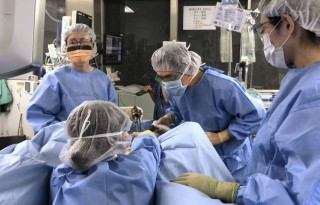Loading
Search
▼ Cancer Patients Give Birth With Frozen Ovaries For The First Time In Japan
- Category:Other
Three cancer patients in their 30s and 40s have successfully given birth using their frozen ovaries while undergoing cancer therapies, according to a Japanese medical school, giving hope to pediatric cancer patients who have yet to menstruate.
The results emerged during a clinical study conducted at St. Marianna in Kawasaki, near Tokyo, who developed the fertility treatment technique. The three cases are the first known births in Japan using a technique involving women undergoing cancer therapies.
Cancer patients may lose the ability to conceive if chemotherapy or radiation treatment damages their ovaries.
It is therefore expected that the Santa Marianna technique will provide patients with more options to preserve their fertility before starting their therapies, and pre-pubertal child patients are more likely to benefit from it as their eggs are difficult to harvest. .
During the clinical trial, the ovaries of cancer patients are cut and quickly frozen after removing the organs using minimally invasive surgery. After patients undergo cancer therapies, the ovaries are thawed and placed back in their previous locations or on the nearby membrane. The ovaries contain numerous ovules.
The medical school has used the technique in a clinical study since 2010, with 13 women who have received ovarian transplants this way so far.
As a result, three women who had already undergone therapies for breast cancer or malignant lymphoma cancer gave birth between 2020 and this year.
The women, including one in Hyogo Prefecture in western Japan, gave birth after becoming pregnant naturally or through IVF.
There are also other options available to cancer patients, such as freezing fertilized or unfertilized eggs. But these options were considered difficult to follow because menstrual cycles do not necessarily coincide with the time patients have before starting therapies and because therapies must be stopped to proceed with these procedures.
This left the ovary-freezing procedure as a viable option because it avoided the need to wait for the right time to harvest the eggs.
Today, however, the advancement of technology has allowed doctors to harvest eggs at any time. This, in turn, changed the focus of the St. Marianna for children whose eggs cannot be collected.
“The latest results could be a godsend for those who have their ovaries frozen in hopes of one day having a baby, while facing the fear of cancer head-on,” said Nao Suzuki, professor of obstetrics and gynecology at the college of medicine.
“You are putting the cart before the horse if cancer treatment is delayed because you wanted to preserve the ovaries,” said the professor, noting that efforts are being made to better coordinate pediatricians to inform patients and their parents about their options in a timely manner.
For Shizuka Ochi, the 42-year-old Hyogo woman who gave birth to a baby boy last October, the ovarian freezing procedure was just what she needed to fight her cancer.
After being diagnosed with breast cancer, the nurse had one of her ovaries removed in March 2014. After undergoing hormone therapy, she had the ovary in June 2019. She later became pregnant through IVF.
“I wanted the chance to get pregnant and give birth after my therapy to work positively with my cancer treatment,” Ochi said.
- November 20, 2022
- Comment (0)
- Trackback(0)


